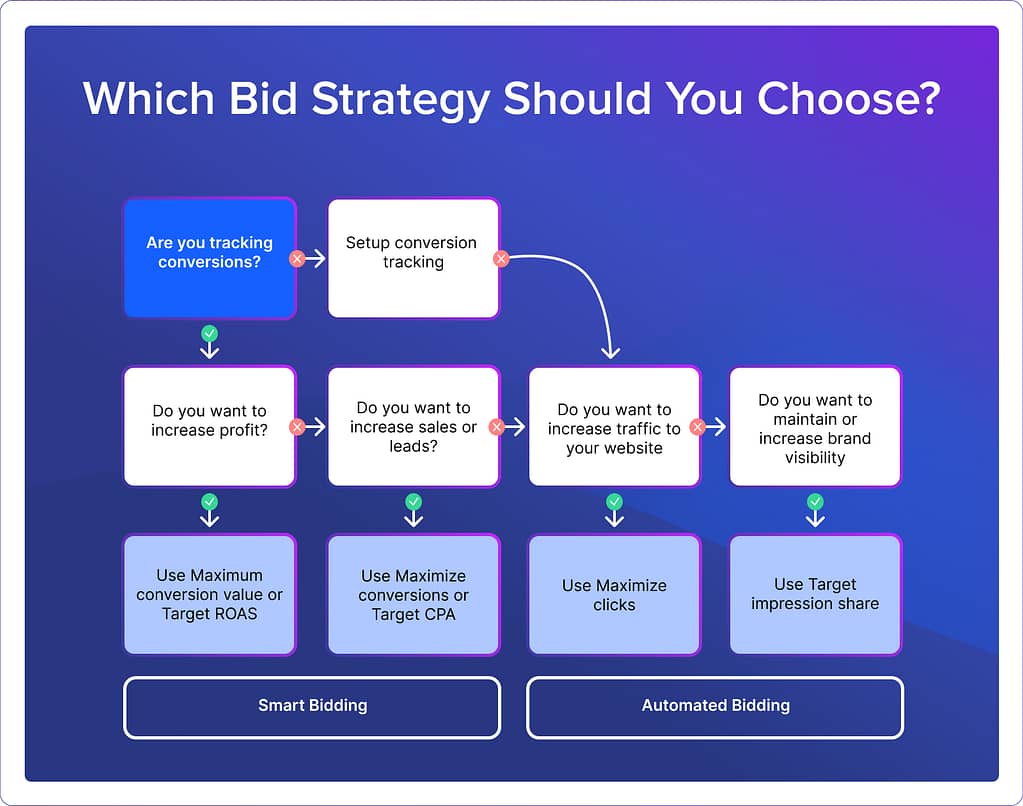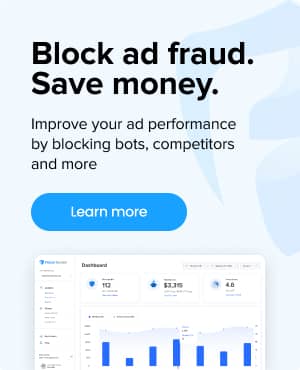What is bid strategy in Google Ads?
Google Ads offers a range of bid strategies tailored to meet your campaign goals. Your strategies will vary based on your campaign’s target network (search, display, etc.) and your objective (more clicks, impressions, conversions, or views).
We’ll cover the difference between manual, automated, and smart bidding, how to align your goals with bid strategies, and list every bid strategies you can use with pros and cons of each. Let’s dive in.
Manual bidding vs. Automated vs. Smart bidding
Before you choose a bid strategy, it’s helpful to understand how these strategies are implemented by Google. Here are three strategies to consider:
Read more: What are key events in Google Ads?
Manual Bidding: As the name implies, you are adjusting the bids manually at the keyword or ad group level. You have maximum control, and are telling Google what you are willing to bid in an auction.
Automated Bidding: These strategies use Google’s machine learning to optimize bids for you based on numerous factors to optimize ad performance.
Smart Bidding: A subset of automated bidding strategy, Smart Bidding, a set of automated bid strategies powered by Google AI, optimizes for conversions or conversion value. It includes strategies like Target CPA, Target ROAS, Maximize Conversions, Maximize Conversion Value, and Enhanced CPC (eCPC). These strategies consider real-time signals like device, location, and language, making them ideal for campaigns aiming at direct action on the website with conversion tracking.

Which bid strategy should you choose?
Your bid strategy should be based on your business goals.
It’s essential to evaluate each of the strategies below based on factors like target audience, ad budget, conversion rates and your historical data. Remember, no strategy is “set it and forget it” – continuous monitoring and adjustments are key to success.

Your Primary Goal: Get More Conversions
If you want customers to take action on your site (buy a product, fill out a lead form) and you use conversion tracking, a Smart Bidding strategy may work well for you. Below are Smart Bidding strategy options:
Target CPA (tCPA): Optimizes conversions at a set cost-per-acquisition.
Pros: Allows for achieving conversions at a specified cost, useful for budget control.
Cons: Requires significant conversion data for effective implementation; no individual bid caps for single campaigns.
Considerations: Set realistic tCPA targets and ensure adequate historical conversion data.
Target ROAS (tROAS): Aims to achieve a specified return on ad spend.
Pros: Optimizes bids to achieve a desired return on ad spend, useful for ROI-focused campaigns.
Cons: Highly dependent on accurate conversion tracking and historical data. Campaigns with lower conversion volume or inconsistent conversion volume may struggle.
Considerations: Avoid setting overly ambitious ROAS targets initially; adjust gradually.
Maximize Conversions: Seeks to maximize conversion numbers within your budget.
Pros: Optimizes for highest possible conversion numbers within your budget. Can now include a target CPA to keep costs in check.
Cons: Potential for very aggressive spending; requires each campaign to have a separate daily budget.
Considerations: Ensure accurate and robust conversion tracking and watch out for increasing CPCs or metrics that are vastly different from historical data.
Maximize Conversion Value: Aims to drive the highest possible conversion value.
Pros: Focuses on bringing in high-value conversions, and considers the quality over quantity of conversions.
Cons: Requires precise conversion tracking and assigning a value to each action.
Considerations: Set realistic conversion values and monitor performance for optimal ROI.
Enhanced CPC (ECPC): Adjusts manual bids to optimize conversions. This strategy is suitable for those preferring some control over their bid settings.
Pros: Increases likelihood of conversions by adjusting bids in real-time. Can improve click-through rate (CTR) and conversion rate (CVR).
Cons: With no hard cap on bid adjustments, there’s a risk of higher-than-expected CPCs. Might not always align with target CPA goals.
Considerations: Monitor CPC and CPA closely to ensure profitability.
Your Primary Goal: Get More Web Traffic
For campaigns aimed at driving traffic, Cost-Per-Click (CPC) bidding strategies like Manual CPC and Maximize Clicks are a good fit. Maximize Clicks automates bid management within a set budget, while Manual CPC allows for individual control over bids for specific ad groups, keywords, or placements. More details on these strategies below:
Manual CPC: Offers complete control over bids at the ad group or keyword level.
Pros: Provide full control over your bids and allows you to fine-tune spend and performance.
Cons: Risk of under-optimizing or over-optimizing if bids are set incorrectly.
Considerations: This bid strategy needs the most active management and a strong understanding of auction dynamics for ideal results.
Maximize Clicks: Focuses on driving the highest possible click volume within your budget.
Pros: Efficient for driving website traffic, particularly beneficial for branding and list building.
Cons: Risk of overspending; clicks may not always translate into quality conversions.
Considerations: Set a maximum CPC limit and regularly review performance against goals.
Your Primary Goal: Increasing Brand Visibility
For campaigns prioritizing brand visibility, impression-based strategies like Target Impression Share, tCPM, and vCPM are recommended. These strategies focus on the frequency and placement of ad impressions, making them apt for increasing brand awareness, especially through image ads and other formats on the Google Display Network.
Target Impression Share: Focuses on achieving a desired impression share.
Pros: Ideal for increasing brand visibility, offering control over ad placement (top of page, absolute top, etc.).
Cons: Potential for high CPCs; may not always optimize for conversions.
Things to Consider: Set a realistic max CPC and monitor performance to avoid overspending.
Target CPM (tCPM): Charges a specified average bid for every 1,000 ad impressions.
Pros: Best for campaigns looking for maximum brand exposure at a specified cost of impressions.
Cons: Similar to Target CPC, there is a risk of under-optimizing or over-optimizing if bids are set incorrectly.
Considerations: With most display campaigns, consider ad frequency and ensure ads are placed on relevant sites.
Viewable CPM (vCPM): Targets a set bid for every 1,000 viewable impressions.
Pros: Suitable for campaigns focused on brand exposure, paying only for viewable impressions.
Cons: Might lead to ad fatigue due to high frequency; not focused on direct conversions.
Considerations: Watch out for frequency and ensure ads are placed on relevant sites.
Your Primary Goal: Video Interactions
Advertisers running video campaigns should consider Cost-Per-View (CPV) bidding. CPV allows you to pay for video views and interactions, such as clicks on CTA overlays. This strategy is effective for increasing engagement with video content.
Maximum CPV (Cost-Per-View): Ideal for video campaigns, focusing on views and interactions.
Pros: Effective for video campaigns, paying only for views or interactions.
Cons: Not ideal for campaigns with loose targeting; views don’t guarantee conversions.
Considerations: Ensure tight targeting for efficiency and monitor view-related metrics.
Understanding and effectively implementing bid strategies in Google Ads can seem daunting at first, but the payoff is significant. By carefully selecting and managing these strategies, marketers can achieve higher ROI, align their campaigns with business goals, and navigate the competitive landscape with confidence.
Frequently asked questions
Can I use multiple automated bidding strategies across different campaigns in Google Ads?
Yes, it’s often beneficial to use different strategies for various campaigns based on their unique goals and performance metrics.
Can automated bidding strategies adapt to sudden market changes?
How frequently can I change bidding strategies?
Google’s learning algorithm needs 1-2 weeks or more to provide effective bidding based your campaign targeting. If you make targeting changes during that period, then it will need to re-learn which placements work best for you.
Related glossary terms:




